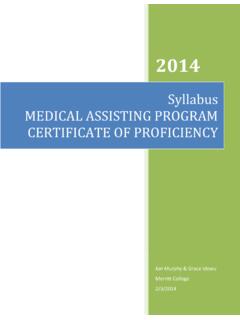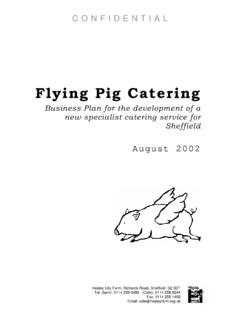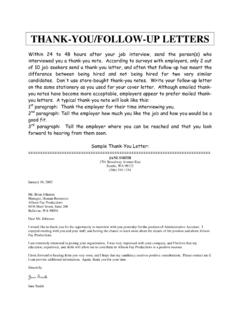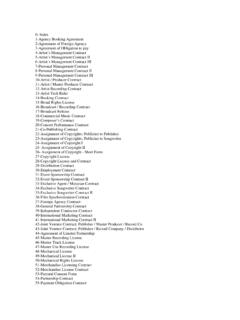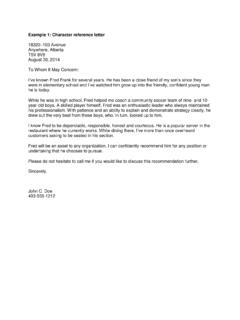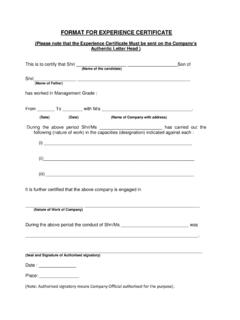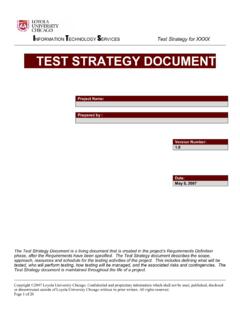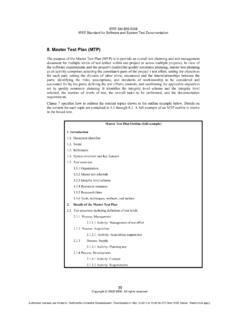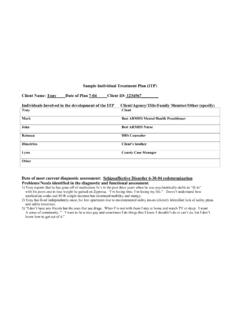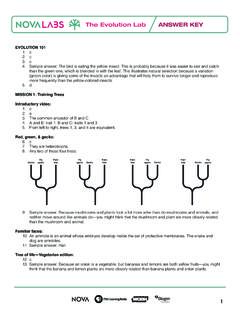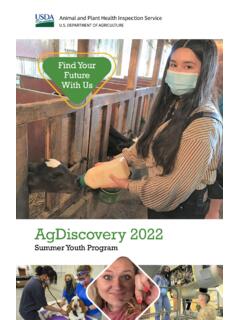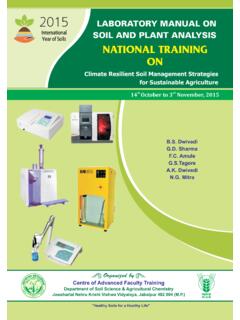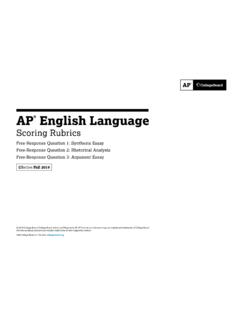Transcription of KINDERGARTEN PLANT LIFE
1 KINDERGARTEN PLANT LIFE 2 weeks LESSON PLANS ANDACTIVITIESMath/Science Nucleus 1990, 20002 LIFE CYCLE OVERVIEW OF KINDERGARTENORGANISMSWEEK : Comparing large and small : Classifying and investigating large : Comparing where large animals live. WEEK : Observing how and where organisms live. LAB: Comparing shells. POST: Comparing plants and animals. HUMAN BIOLOGYWEEK : Discovering the different parts of the body. LAB: Discovering and locating parts of the body. POST: Distinguishing the function of external body parts. WEEK : Discovering why bones are : Comparing different models of skeletons. POST: Exploring how teeth grow. PLANT LIFEWEEK : Exploring how seeds : Planting seeds. POST: Exploring the uses of plants . WEEK : Defining the parts of a tree and flower. LAB: Comparing seeds and the plants they produce. POST: Comparing flowers, stems, and ENVIRONMENTWEEK : Exploring land and marine environments.
2 LAB: Comparing and contrasting environments. POST: Describing a favorite 8:PRE: Exploring the order of a natural community. LAB: Dramatizing who eats whom. POST: Characterizing producers and Nucleus 1990, 20003 LIFE CYCLE - plants (KA)PRE LABOBJECTIVES:1. Describing Exploring how seeds grow. VOCABULARY:bulbphotosynthesisseedMATERIA LS: crayonsworksheetBACKGROUND: plants are living organisms and share common characteristics with all other livingthings. All organisms are composed of cells, grow, reproduce, and respond to variouskinds of stimuli like temperature. However, plants have additional characteristics whichdistinguishes them from other organisms. plants have the ability to manufacture food(photosynthesis); have unlimited or almost unlimited growth; and cell walls made ofcellulose (used in making paper). Students should learn that most plants are green, haveroots, grow, have flowers, have leaves, live in soil, and drink water.
3 The kingdom of plants includes seed plants , algae, ferns, and mosses. plants havemany cells and tissues. They make their own food using chlorophyll (the green pigment)through a chemical process called photosynthesis, which converts water and carbondioxide into sugars, if there is enough light. They do not move on their own. Children sometimes mistake some invertebrate animals, like coral or sea anemonesas plants . Children reason that if it looks like a PLANT , it is a PLANT . Even mushrooms, mostchildren think is a PLANT because it grows. Children that just see a part of PLANT like a bulb,root, or seed may not think it is a PLANT because it is not green. PROCEDURE:1. Discuss with students the needs of plants which include water, air, soil, light, andmoderate temperatures. You may want to make an overhead of the worksheet and discusswith children why or why not each is a PLANT . For each box ask students to answer thefollowing questions in their mind before they answer yes or determine what is a PLANT byusing a worksheet.
4 Math/Science Nucleus 1990, 20004 Does it move? (no)Does it make its own food? (yes)Can it live in the dark? (no)Does it need soil to grow big? (yes)Is it green? (yes)Is it part of a PLANT ? (yes or no)2. If their answer corresponds then it is most likely a PLANT . Get your students toreason out the answer and not to just give an answer. Although the frog is green it isn't aplant and an onion is only part of a PLANT , that's why it isn't green. The mushroom is nota PLANT , it is a fungi which cannot produce its own food from the sun. 3. You may want to go outside and have the students determine what is a even grasses and weeds are plants !Math/Science Nucleus 1990, 20005 LIFE CYCLE - plants (KA) PREWHAT ARE plants ?PUT A CIRCLE AROUND THOSE THINGS THATARE plants ?Math/Science Nucleus 1990, 20006 LIFE CYCLE - plants (KA)LABOBJECTIVES:1. Planting Experimenting with the requirements of PLANT growth.
5 VOCABULARY:lightnutrientseedwaterMATERIA LS: milk containerssoilseedswaterplastic spoonsrocksBACKGROUND:Planting and watching seeds grow is a wonderful experience for children. A seedis like magic, a seemingly lifeless thing, that can grow into a living PLANT . Growing seedscan be a very inspirational activity, especially if the children are allowed to watch the seedgrow and mature. Watching plants grow will also teach students patience andobservational skills. The requirements for growing a PLANT is water, nutrients, and sunlight. Too muchor too little of these requirements can prevent a PLANT from growing. This activity has thestudents looking at the key components of nutrients, so they need to have the soil. In thefirst grade the students will grow seeds again, but without the soil. In the first grade theywill be concentrating on actual mechanism of growth, while KINDERGARTEN is focused on allthe components.
6 PROCEDURE:During this activity the students will prepare the growing environments for theirseeds, PLANT them, water them, and then watch them grow. Prior to this activity you mayrequest from parents any old seeds that they may not have used. Students PLANT a seed andwatch it Nucleus 1990, 200071. Save milk containers and cut off the tops. Punch small holes at the bottom of thecontainers. Tell the students that when the seeds grow and the roots get larger, theyneeds air. Water is important, but too much water sitting in the container can "rot" theroots. The rocks are used to prevent the roots from touching the bottom and getting watersoaked. Instruct students to place a few small rocks on the bottom of the milk container,just enough to make one layer. Get a bucket of soil and have the students fill the milkcontainers 3/4 full of soil. 2. Place the seed about 1 centimeter into the soil.
7 This will vary depending on thetype of seed (refer to the package the seeds came in). When the students water theirseeds, first have them use a spray bottle to water, so that they make the "home" for theseed ready because pouring water will unsettle the seed. They can start to pour water,when the seed starts to root. 3. Move the seed to a warm area, but not into direct sunlight. Again this will dependon the seeds. The seed provides food for the PLANT until the leaves are formed, which willthen let the PLANT produce its own food. We recommend that you read the directions to thestudents so they understand that you must do this for each package of seeds you get. 4. Be careful that the students do not over water their seeds. It is OK for the soilto dry a little, a soaking wet soil is not the best environment. Math/Science Nucleus 1990, 20008 Flour is made from CYCLE - plants (KA)POST LABOBJECTIVES:1.
8 Exploring the uses of Showing and demonstrating some uses of plants . VOCABULARY:fiberplantMATERIALS: items that are made from plantsSwift GH Microscope or hand lensBACKGROUND: plants are very useful in our society. The old saying, Either you grow it, or mine it, still holds true. Children are not aware of where items they use everyday come may be used for decoration, erosion and climate control (wind breaks and shade),foods, beverages, flavoring, medicines, fabrics, rope and other fibers, wood, rubber, dyes,paper, and many other uses. Many clothes are still made from cotton, which is grown on plants and that is made of polyester is synthetic and has a petroleum base. Medicines likeaspirin come from a tree. Scientists are discovering new medicines from plants every taste from many soft drinks, even cola, comes from various plants . plants mostimportant contribution to humans, is the food potential.
9 Grains are used in many foodproducts, especially flour. Even the morning breakfast is from plants . Oatmeal from oat;corn flakes from corn; and bran flakes from wheat. Most societies are based on one grainas their staple. Many parts of Asia use rice; parts of North America and Europe use flour;and Central America uses corn as its staple. PROCEDURE:1. Instruct children to look around the classroom for items made from plants . Theymight find paper, wood desks, rulers, balloons, rubber bands, erasers, cotton shirts,decorative plants , something made with natural dyes, pencils, twine, baskets, bayberrycandles, mint chewing gum (both gum and flavoring come from plants ) and many otherthings. Make a list on a piece of paper. Continue writing new items when students goStudents look closely at items madefrom plants . Math/Science Nucleus 1990, 20009home and ask their parents if they know anything else that comes from plants .
10 2. Most students do not realize that cotton is grown on a PLANT . If you have a cottonplant with a bud of cotton, show the students that the little ball of cotton is then made intofibers that can be used for spinning. Show students different kinds of cotton to students the difference between wool and polyester. Wool is from sheep andpolyester is from an oil based product. You may want the students to bring one or twoproducts from home that are made from plants . Have a "show and tell," products fromplants. 3. Put a few microscopes out with different types of fabric. Let the students lookat the differences in the threads that make up the various fabrics. Cotton fibers, forinstance, have a distinct texture composed of flat ribbons. Linen fibers are jointed likebamboo. 4. You may want to make another list of PLANT foods that students ate. Instruct themto ask their parents help and read labels of items they eat, to see if plants were involvedin making the product.
